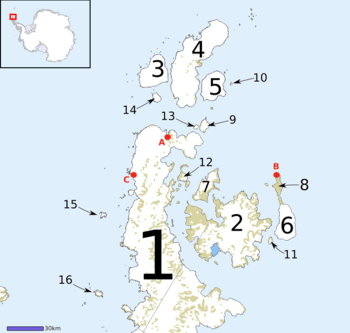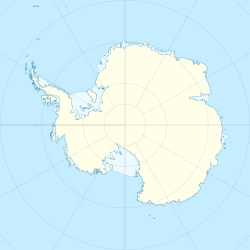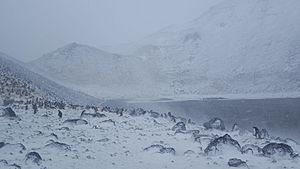Paulet Island facts for kids

Map of Graham Land, showing Paulet Island (10)
|
|
|
Location in Antarctica
|
|
| Geography | |
|---|---|
| Location | Antarctica |
| Coordinates | 63°35′S 55°47′W / 63.583°S 55.783°W |
| Archipelago | Joinville Island group |
| Length | 1.5 km (0.93 mi) |
| Width | 1.5 km (0.93 mi) |
| Administration | |
| Administered under the Antarctic Treaty System | |
| Demographics | |
| Population | Uninhabited |
| Paulet Island | |
|---|---|

Paulet Island, December 2004
|
|
| Highest point | |
| Elevation | 353 m (1,158 ft) |
| Prominence | 353 m (1,158 ft) |
| Geography | |
| Location | Antarctic Peninsula, Antarctica |
| Geology | |
| Mountain type | Cinder cone |
| Last eruption | Unknown |
Paulet Island is a round island in Antarctica. It's about 1.5 kilometers (about 1 mile) wide. You can find it southeast of Dundee Island, near the tip of the Antarctic Peninsula. Many people visit Paulet Island because it has a huge colony of penguins.
Contents
About Paulet Island
Paulet Island is actually a volcano! It's made of hardened lava from old eruptions. At the top, there's a small cone with a crater, like a bowl.
Some parts of the island don't have ice. This is because of geothermal energy, which is heat from inside the Earth. Scientists think the volcano might have erupted within the last 1,000 years. Paulet Island is part of a group of volcanoes called the James Ross Island Volcanic Group.
History of the Island
A British team led by James Clark Ross found Paulet Island between 1839 and 1843. Ross named the island after George Paulet, a captain in the British Royal Navy.
Shipwrecks and Survival
In 1903, a ship called the Antarctic was exploring the area. It was part of the Swedish Antarctic Expedition led by Otto Nordenskiöld. Sadly, the ship got stuck in the ice and sank near Paulet Island.
The crew members survived and built a stone hut on the island in February 1903. They also built a cairn (a pile of stones) on the highest point. This was to help rescuers spot them. One expedition member died and was buried there.
Today, the stone hut, the grave, and the cairn are protected. They are known as a Historic Site or Monument (HSM 41). This was decided by countries that are part of the Antarctic Treaty System.
Another famous ship, the Endurance, also had plans to go to Paulet Island. The Endurance crew became stranded on ice. They hoped to reach the island to use supplies left by the Swedish expedition. But the ice they were on drifted too far away.
Home to Many Birds
Paulet Island is a very important place for birds. BirdLife International has named it an Important Bird Area (IBA). This is because it's home to a very large bird colony.
About 100,000 pairs of Adélie penguins live and breed here! Other birds that nest on the island include imperial shags, snow petrels, and kelp gulls.
Gallery
Images for kids
See also
 In Spanish: Isla Paulet para niños
In Spanish: Isla Paulet para niños






